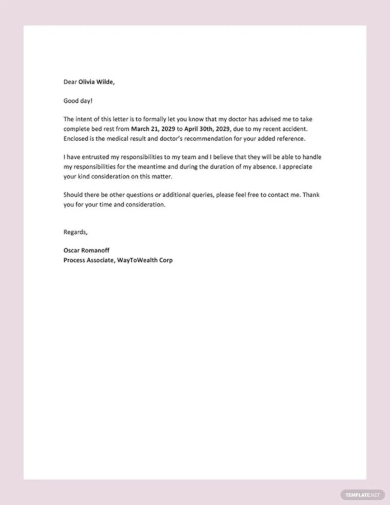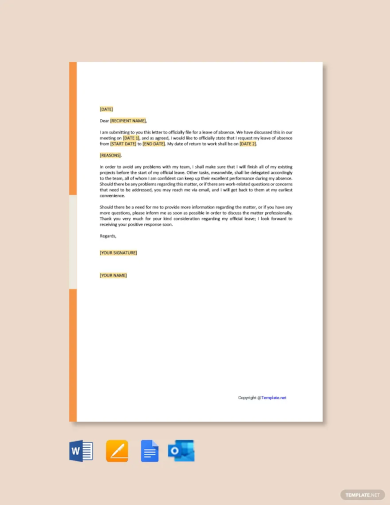28+ Official Letter for Leave Examples to Download
Even the most career-driven individuals need some time off from work. Perhaps going on a vacation leave to the Bahamas will help you unwind, or maybe your doctor has advised you to take the entire week off to rest. You may also see leave application email examples.
Whatever the reason may be, it’s important to submit an official letter for leave to notify employers of your absence. It’s important to put your request in writing for documentation and formality. This makes it easier for your manager to understand why you’re asking for a leave, therefore increasing your chances of being granted.
Though leave letters are supposed to be fairly common in a professional setting, many people still struggle with constructing one. Learning how to compose a good letter for leave will certainly come in handy when you need one the most. You may also like official medical leave letter examples.
What is Official Letter for Leave?
An Official Letter for Leave is a formal written request addressed to an employer or manager, asking for a temporary absence from work. This type of letter is essential in the professional world as it communicates the employee’s intention to take leave, ensuring that their absence is documented and approved according to the organization’s policies. The purpose of the letter is to inform the employer of the leave dates, the reason for the leave, and how the employee plans to manage their duties during their absence, if applicable.
Official Letter for Leave Format
Heading
- Your Name: Full name of the employee requesting leave.
- Your Job Title: Your current position within the company.
- Company Name: The name of the organization you work for.
- Company Address: The address of your workplace.
- Date: The date the letter is written.
Recipient Information
- Recipient’s Name: The name of the manager or HR representative the letter is addressed to.
- Recipient’s Job Title: Their position within the company.
- Company Name: The name of the organization, if not included in the heading.
Opening
- Subject Line: Clearly state the purpose of the letter, e.g., “Leave of Absence Request.”
- Salutation: A formal greeting, such as “Dear Mr./Ms. [Last Name],”
Body
- Introduction and Leave Request: State the purpose of the letter, specifying the type of leave (annual, medical, maternity, etc.) and the exact dates of the leave period.
- Reason for Leave: Briefly explain the reason for your leave request, providing enough detail to justify the necessity without oversharing personal information.
- Plan for Responsibilities: If applicable, describe how you intend to manage your work before your leave, including any arrangements for delegating tasks or completing projects in advance.
Closing
- Conclusion: Express appreciation for the recipient’s consideration of your leave request.
- Signature: Close with a formal sign-off, such as “Sincerely” or “Best regards,” followed by your handwritten signature (if submitting a hard copy) and typed name.
Sample Format
John Doe
Software Developer
123 Coding Lane
Techville, TX, 75001
September 26, 2024Jane Smith
Human Resources Manager
Innovatech Solutions
456 Tech Park Drive
Techville, TX, 75002Subject: Leave of Absence Request
Dear Ms. Smith,
I am writing to formally request a two-week leave of absence from my position as Software Developer, starting from October 10, 2024, to October 24, 2024, due to personal reasons related to my family’s well-being.
During my absence, I have arranged for my colleague, Mark Taylor, to cover critical aspects of my role, including ongoing project support and client communications. I will ensure all pending tasks are completed before my leave begins and will be available for any urgent queries via email.
Thank you for considering my request for this leave of absence. I am willing to discuss this further and provide any additional information required. I appreciate your understanding and support in this matter.
Sincerely,
John Doe
What is an example of a Official Letter for Leave?
[Your Name]
[Your Position/Title]
[Your Company or Organization Name]
[Your Address]
[City, State, ZIP Code]
[Email Address]
[Phone Number]
[Date]
[Recipient’s Name]
[Recipient’s Position/Title]
[Company or Organization Name]
[Address]
Dear [Recipient’s Name],
I hope this letter finds you well. I am writing to formally request a leave of absence from [start date] to [end date]. The purpose of my leave is [briefly explain the reason for your leave, such as personal matters, family issues, medical reasons, etc.].
I have taken all necessary steps to ensure a smooth transition during my absence. I have briefed [colleague’s name or department] about the status of my current projects and tasks. I am also willing to provide any additional information or assistance required to ensure a seamless workflow in my absence.
I understand the importance of my role and responsibilities, and I am committed to completing any pending tasks before my departure. If there are any urgent matters that require my attention during the leave period, I can be reached via [provide an alternative contact method, if applicable].
I have attached any relevant supporting documents, such as a medical certificate or any other documentation required for the approval of my leave.
I kindly request your approval for this leave and would appreciate any guidance regarding the formalities or paperwork associated with the process. I am dedicated to ensuring that my absence does not adversely impact [the company/organization], and I will make every effort to ensure a smooth return to work.
Thank you for considering my request. I look forward to your positive response.
Sincerely,
[Your Full Name]
[Your Signature]
[Attachment: Supporting Documents, if any]
Leave Letter for Different Purposes
- Official Leave Letter for Fever
- Official Leave Letter for Marriage
- Official Leave Letter for Exam
- Official Leave Letter for Eye Pain
- Official Leave Letter for Festival
- Official Leave Letter for 3 Days
- Official Leave Letter for Vacation
- Official Leave Letter for Family Emergency
- Official Leave Letter for One Day
- Official Leave Letter for Annual Leave
18+ Best Official Letter for Leave Examples
1. Request Letter for Leave Template
Download2. Official Leave Letter Format Template
Download3. Formal Sick Leave Application Letter Example
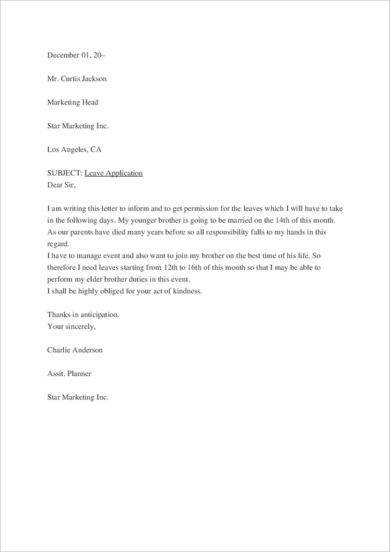
4. Holiday Leave Request Letter Example
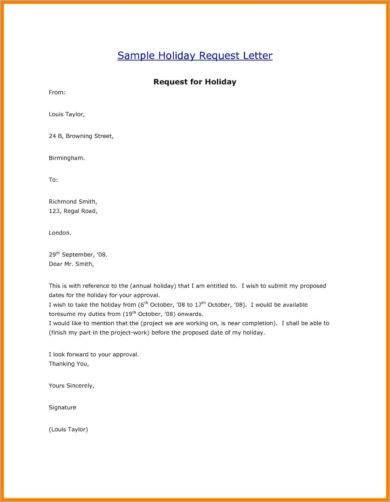
5. Leave Request Mail to Manager
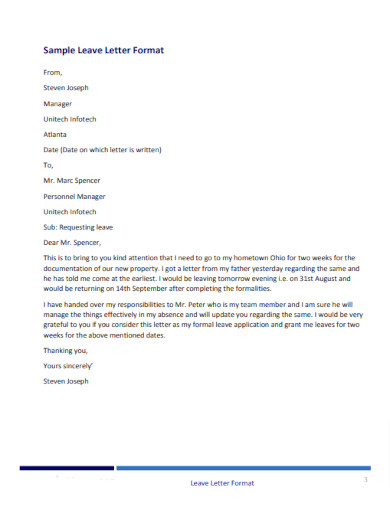
6. Leave Letter Format for Office
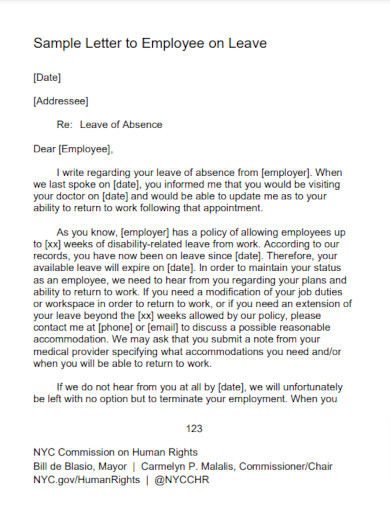
7. Leave Letter Format for School
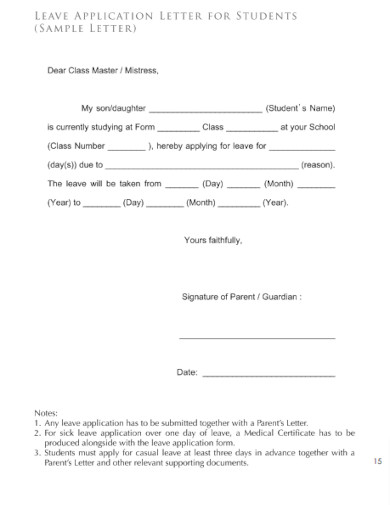
8. Official Letter for Leave For Personal Use
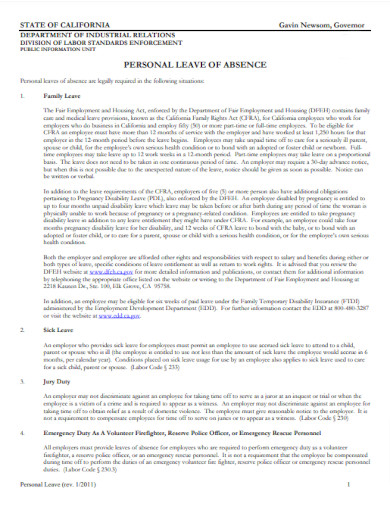
9. Official Letter for Leave to Principal
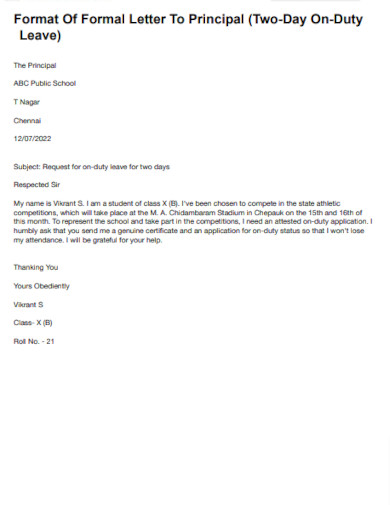
10. Official Letter for Leave for Marriage
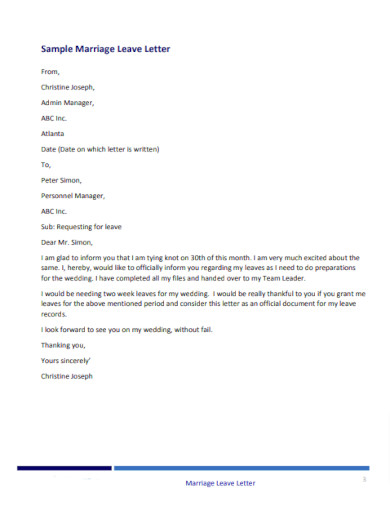
11. Official Letter for Leave Request
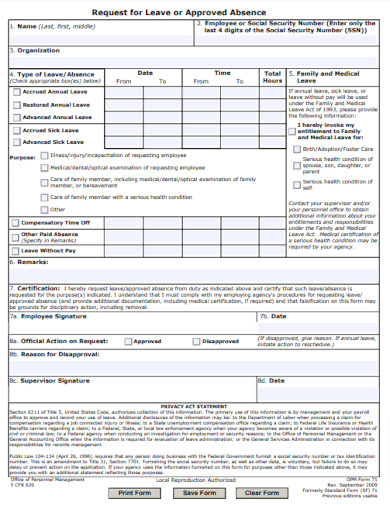
12. Sample Official Leave of Absence Letter Example
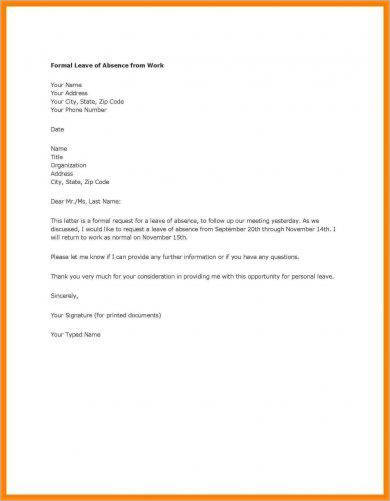
13. Official Bereavement Leave Letter Example
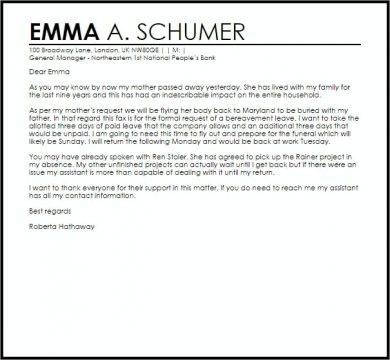
14. Official Leave Letter from Work Example
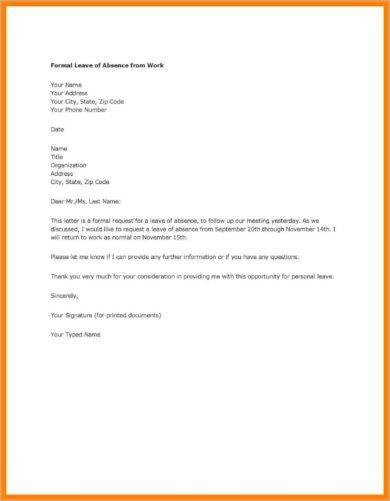
15. Official Letter for Leave of Absence Example
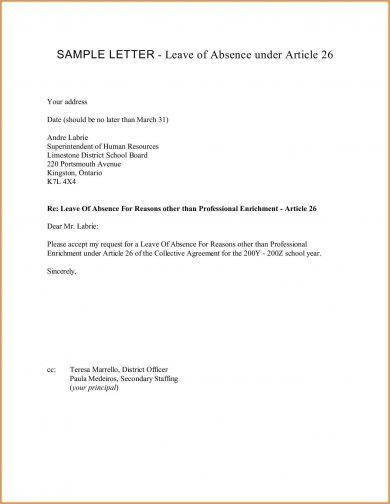
16. Official Letter for Sick Leave Example
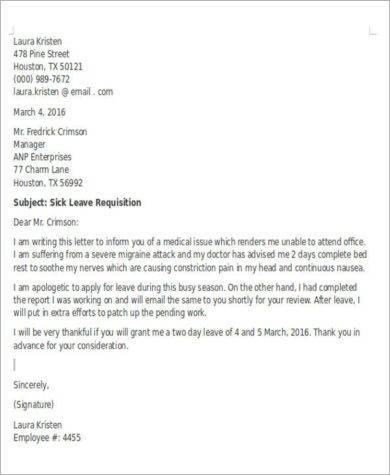
17. Official School Leave Letter Example
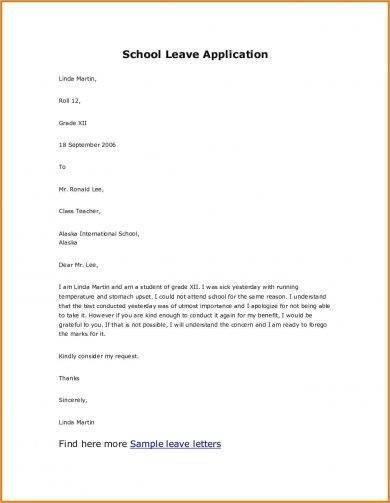
18. Paternity Leave Letter Example
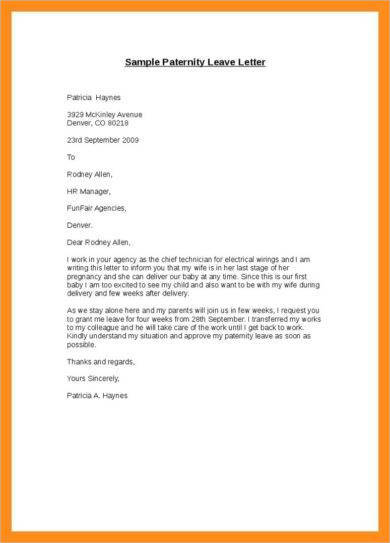
19. Personal Work Leave Letter Example
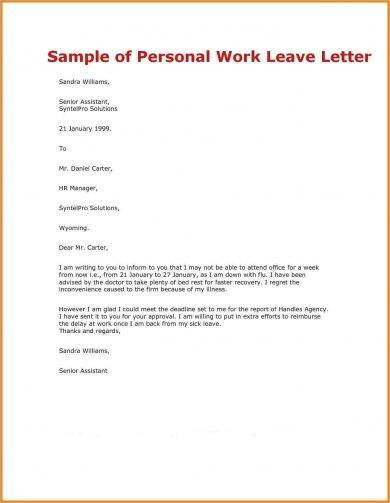
What to Include in the Letter
When requesting a formal leave of absence, there are a few components that must be included in your letter:
1. Request for the leave
This should be indicated clearly in the professional letter. It must be kept brief and to the point to ensure that the reader understands your message. It isn’t necessary to go into detail in regards to your situation, especially when it’s something too sensitive to discuss out loud. Since most people tend to skim through a letter to get to the central point of it, you might want to indicate your purpose right at the beginning of your letter.
2. The dates you expect to be away from work
Do you plan to be on leave for two weeks, three weeks, or perhaps even two whole months? If you do, then be sure to indicate this in your simple letter. You don’t have to make a list of consecutive days, but you do need to provide the starting date for these days, followed by the number of days or weeks you expect to be away.
3. The return date
Unless you plan to be away for only a day or two, you need to specify your return date. If you aren’t sure about the exact date yet, then you can always provide an estimation for this. For instance, if the surgeon advises you to take a rest for three weeks after a major surgery, then you can indicate this in your general letter.
4. An offer to provide assistance
Even if you are entitled to a leave from work, you don’t want to make it seem like you’re abandoning your job. There are may be paperwork that need to be filed and projects to settle before a given deadline, so you need to make sure these are taken care of by your substitute, or if possible, yourself. You may also see offer letter examples.
You can choose to orient your replacement regarding the amount of work that must be attended to, or you can make a deal to work at home for the time being. The latter is only suggested if you’re physically capable of completing a few tasks while you’re away. You may also like cover letter examples.
5. Words of thanks
Regardless of the outcome, always remember to thank your reader for even considering the request. A few words of gratitude depict professionalism despite the circumstance at hand.
A Guide to Requesting Leave from Work
The process for requesting a formal leave is pretty simple. The first thing you would need to do is to discuss your current situation with your manager or with your company’s human resources department.
This is usually done through a letter addressed to your immediate supervisor. Though handwritten or typewritten letters may not be as common as professional emails, they are still an option that’s open for you to use.
The formal letter should request a meeting with the recipient to discuss how the leave can be applied for. Once this has been carried out, you can then make a written request for your leave of absence. This will be used to assess whether or not your leave will be granted by the company’s management.
However, take note that this process may differ depending on your company’s policies. The general policy should specify the possible reasons for leave, along with the number of times employees are allowed to take a leave from work. It would be best to read your company’s handbook to get your answers to these questions. If you find a policy in place, make sure to adhere to the guidelines indicated in the instructions.
Approved Leaves from Work
There are many reasons why an employee may ask for a leave. By law, employers are obliged to grant these requests as long as they obey company policy. Although there are circumstances when the company may not be required to pay you while you’re away, there are legal protections issued to ensure that you can return to your job as soon as your leave is finished.
Some of these reasons are completely mandatory, such as during the birth or adoption of a child (maternity and paternity leave), particular medical conditions, or even to honor a military commitment. There are legal guidelines that a business must follow, otherwise they could pay a fine and face serious legal issues with the local government. You may also see leave application examples.
As for a personal leave that is usually taken voluntarily, such as continuing your education, illness, or personal stress, the company does have the authority to approve or deny your request.
Generally, your leave may possibly be granted if you take the appropriate measures.
1. Give notice.
Inform your direct supervisor or manager about the leave beforehand. Unless your reasons are urgent and unexpected, refrain from doing this just a few days before you actually take some time off. You need to be clear and specific with your reason for it to be accepted. You also need to deal with the requirements set by HR associated with leave. You may also like leave policy examples.
2. Know your rights.
You are entitled to a certain amount of leaves, paid or unpaid, before the company can take matters into their own hands. But you should know that this only applies to certain circumstances. You can discuss this with your company’s HR to learn more.
3. Speak to your supervisor.
Do not leave your supervisor in the dark. You might be away for 8 weeks to undergo an important surgery. When this happens, your supervisor would need to find someone to take your place. Your temporary replacement may or may not be familiar with your workload, so you need to make sure that they’re given the heads-up in advance. You may also check out how to write a confusion regarding sick leave policy letter.
4. Ask verbally and in writing.
Along with a formal letter, having a face-to-face conversation with your supervisor is highly advisable. While you aren’t obligated to let them know every single detail of your situation, they still have the right to know why you’re taking some time off from work. The more aware they are, then the more understanding they’re likely to be. After the meeting, you can compose a letter for documentation purposes, which will then go to your personal file.
How to Write an Official Letter for Leave
Asking for leave isn’t always an easy way out. Employers wouldn’t want a valued member of their team to be gone for so long, but there are also some things that they won’t be able to control but should otherwise accept. To make it easier for everyone involved, here are some tips to keep in mind:
1. Warn your employer in advance.
If a member of your family is facing a life-threatening medical condition, for example, you need to let your employer know beforehand since they’re likely to expect you to take some time off to deal with the situation in case it takes a turn for the worst. You can have this discussion privately and face-to-face to make sure that your employer understands what you’re going through. You may also see notice letter examples.
2. Send an application.
You should only send an application after you’ve already warned your employer. Even if you need an approval for a much needed vacation leave or a medical leave, your chances of being approved is highly likely if you give a word of warning prior to sending the application.
3. Be specific with your purpose.
Many people lie their way to getting a leave just so they can take some time off from work to go on vacation or get some extra sleep at home. If you don’t want to get caught and gain a bad reputation from your manager, you might want to be as transparent as possible. Be honest and open about your time off. You may also like two weeks notice letter examples.
Unless you’re not comfortable to do so, make sure you explain why you need the leave or how it will benefit the company. Employers can be pretty understanding if you’re being reasonable enough.
4. Discuss how your absence will be handled.
As an employee of a company, you have your own set of responsibilities to attend to. But since you won’t be able to report for duty for a certain number of days, you need to let your employer know how you plan to distribute your work. You can also delegate some tasks to other members of your team during your absence. This says a lot about your character and your willingness to stay proactive despite the circumstance at hand. You may also check out formal notice examples.
5. Consider possible alternatives.
If it’s possible to get some tasks done during this period of absence, don’t hesitate on letting your employers know about it. This is beneficial for both parties, as you’re likely to still get paid for doing the same things you could be doing at the office, and the company wouldn’t have to worry about hiring a temporary replacement or unloading all the responsibilities to a certain member of the team. You might be interested in employee notice examples.
The objective of writing an official letter for leave is to inform your boss about your proposed absence from work. By doing so, you’re expressing a form of professionalism as an employee by having the initiative to take action. Whether it’s for personal reasons, illness, or to further your education, asking for an extended leave that is longer than your typical holiday allowance can be a tricky situation to be in. This is why it’s important to learn how you can format your leave of absence to generate the desired response.
Dos and Don’ts for Requesting a Official Leave
Dos for Requesting Official Leave:
1. Provide Advance Notice:
Do submit your official leave request well in advance, adhering to any specified notice periods in your company policies.
2. Use Professional Language:
Do maintain a professional and formal tone in your written leave request.
3. Specify Dates Clearly:
Do clearly state the dates for your leave, including the starting and ending dates.
4. Explain Reason Briefly:
Do offer a concise and honest explanation for your leave, ensuring it aligns with company policies.
5. Offer Assistance:
Do express your willingness to assist in the transition and provide necessary information for a smooth workflow during your absence.
6. Follow Company Procedures:
Do adhere to company procedures and guidelines for requesting official leave, including the submission of required forms or documentation.
7. Attach Supporting Documents:
Do attach any relevant supporting documents, such as a medical certificate or other documentation, depending on company requirements.
8. Express Gratitude:
Do express gratitude for the consideration of your leave request and reiterate your commitment to fulfilling responsibilities upon your return.
Don’ts for Requesting Official Leave:
1. Don’t Delay Submission:
Don’t wait until the last minute to submit your leave request; adhere to any advance notice requirements.
2. Avoid Ambiguity:
Don’t be unclear about the dates or reasons for your leave; provide precise and accurate information.
3. Avoid Over-Sharing Personal Details:
Don’t include unnecessary personal details in your request; keep it professional and focused on the relevant information.
4. Don’t Assume Automatic Approval:
Don’t assume automatic approval; await official confirmation from the relevant authority or department.
5. Avoid Informal Language:
Don’t use informal language or casual expressions in your leave request; maintain a formal and respectful tone.
6. Don’t Forget to Follow Up:
Don’t forget to follow up if you haven’t received a response within the expected timeframe, following company protocols.
7. Avoid Ignoring Company Policies:
Don’t ignore or bypass company policies; adhere strictly to established procedures for leave requests.
How do I write a professional leave of absence letter?
Format and Layout:
- Use a formal business letter format with your name, address, date, recipient’s name, recipient’s title, and the company or organization’s address.
- Add a formal salutation at the beginning of the letter (e.g., “Dear [Recipient’s Name],”).
2. Introduction:
- Begin with a brief introduction, stating your intention to formally request a leave of absence.
3. Leave Details:
- Clearly specify the dates you intend to be on leave, including the start date and end date.
4. Reason for Leave:
- Briefly explain the reason for your leave. Be honest and provide sufficient detail without divulging overly personal information.
5. Assure Smooth Transition:
- Express your commitment to ensuring a smooth transition during your absence. Mention if you’ve taken steps to prepare your responsibilities or if you are available to provide information.
6. Offer to Assist:
- Express your willingness to assist in any way to ensure the continuity of work. Provide contact details in case of urgent matters.
7. Company Procedures:
- Mention that you are aware of and have followed company procedures for requesting a leave of absence. If required, state that you have attached any necessary supporting documents.
8. Closing:
- Express gratitude for considering your request.
- Reiterate your commitment to fulfilling any pending responsibilities upon your return.
9. Formal Closing:
- End the letter with a formal closing (e.g., “Sincerely,”).
10. Signature:
- Sign the letter with your full name.
How do I write a letter to my boss for leave?
Subject: Leave of Absence Request
[Your Full Name] [Your Position/Title] [Your Company Name] [Date]
[Supervisor’s Full Name] [Supervisor’s Position/Title] [Company Name] [Company Address]
Dear [Supervisor’s Last Name],
I trust this message finds you well. I am writing to formally request a leave of absence from work due to [briefly explain the reason, such as personal matters, family issues, medical reasons, etc.].
The proposed dates for my leave are [start date] to [end date]. I have taken the necessary steps to ensure that my current projects and tasks are up to date. Additionally, I have briefed [colleague’s name or department] on the status of my work and provided documentation to facilitate a smooth workflow during my absence.
I understand the importance of my role within the team and am committed to ensuring a seamless transition. I am willing to assist remotely if necessary and can be reached via email or phone during my leave for any urgent matters.
I have attached any relevant supporting documents, such as a medical certificate, to assist in the processing of my leave request.
I appreciate your prompt attention to this matter and kindly request your approval for this leave. If there are any specific procedures or forms that I need to complete, please advise accordingly.
Thank you for your understanding. I look forward to your positive response.
Best regards,
[Your Full Name] [Your Position/Title] [Your Contact Information]
General FAQ’s
What is a leave of absence?
A leave of absence is a period during which an individual is granted permission to be away from work, school, or other obligations, typically for personal, medical, or family reasons.
Are employers required to give employees paid leave from work?
In many places, employers are not universally required to provide paid leave. Paid leave policies often depend on local labor laws, company policies, and the employment contract.
What’s the best way to request a leave from work?
To request a leave from work, submit a formal written request to your supervisor. Specify the dates, reason, and any preparations made. Be clear, concise, and professional in your communication.
28+ Official Letter for Leave Examples to Download
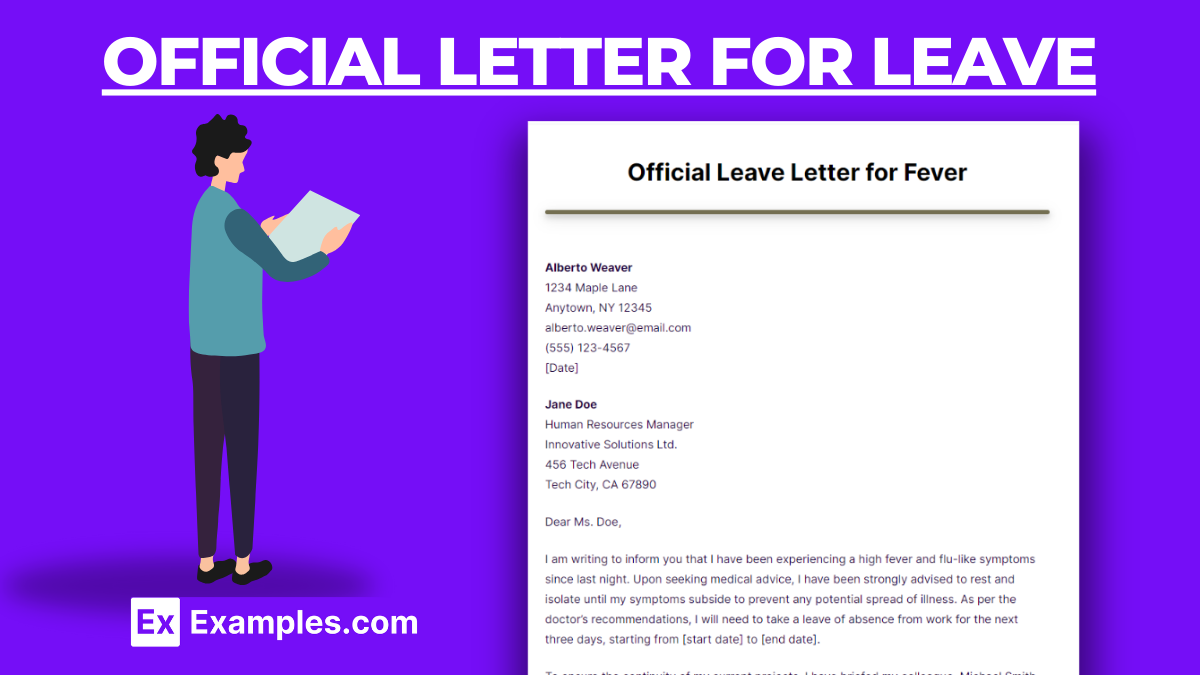
Even the most career-driven individuals need some time off from work. Perhaps going on a vacation leave to the Bahamas will help you unwind, or maybe your doctor has advised you to take the entire week off to rest. You may also see leave application email examples.
Whatever the reason may be, it’s important to submit an official letter for leave to notify employers of your absence. It’s important to put your request in writing for documentation and formality. This makes it easier for your manager to understand why you’re asking for a leave, therefore increasing your chances of being granted.
Though leave letters are supposed to be fairly common in a professional setting, many people still struggle with constructing one. Learning how to compose a good letter for leave will certainly come in handy when you need one the most. You may also like official medical leave letter examples.
What is Official Letter for Leave?
An Official Letter for Leave is a formal written request addressed to an employer or manager, asking for a temporary absence from work. This type of letter is essential in the professional world as it communicates the employee’s intention to take leave, ensuring that their absence is documented and approved according to the organization’s policies. The purpose of the letter is to inform the employer of the leave dates, the reason for the leave, and how the employee plans to manage their duties during their absence, if applicable.
Official Letter for Leave Format
Heading
Your Name: Full name of the employee requesting leave.
Your Job Title: Your current position within the company.
Company Name: The name of the organization you work for.
Company Address: The address of your workplace.
Date: The date the letter is written.
Recipient Information
Recipient’s Name: The name of the manager or HR representative the letter is addressed to.
Recipient’s Job Title: Their position within the company.
Company Name: The name of the organization, if not included in the heading.
Opening
Subject Line: Clearly state the purpose of the letter, e.g., “Leave of Absence Request.”
Salutation: A formal greeting, such as “Dear Mr./Ms. [Last Name],”
Body
Introduction and Leave Request: State the purpose of the letter, specifying the type of leave (annual, medical, maternity, etc.) and the exact dates of the leave period.
Reason for Leave: Briefly explain the reason for your leave request, providing enough detail to justify the necessity without oversharing personal information.
Plan for Responsibilities: If applicable, describe how you intend to manage your work before your leave, including any arrangements for delegating tasks or completing projects in advance.
Closing
Conclusion: Express appreciation for the recipient’s consideration of your leave request.
Signature: Close with a formal sign-off, such as “Sincerely” or “Best regards,” followed by your handwritten signature (if submitting a hard copy) and typed name.
Sample Format
John Doe
Software Developer
123 Coding Lane
Techville, TX, 75001
September 26, 2024Jane Smith
Human Resources Manager
Innovatech Solutions
456 Tech Park Drive
Techville, TX, 75002Subject: Leave of Absence Request
Dear Ms. Smith,
I am writing to formally request a two-week leave of absence from my position as Software Developer, starting from October 10, 2024, to October 24, 2024, due to personal reasons related to my family’s well-being.
During my absence, I have arranged for my colleague, Mark Taylor, to cover critical aspects of my role, including ongoing project support and client communications. I will ensure all pending tasks are completed before my leave begins and will be available for any urgent queries via email.
Thank you for considering my request for this leave of absence. I am willing to discuss this further and provide any additional information required. I appreciate your understanding and support in this matter.
Sincerely,
John Doe
What is an example of a Official Letter for Leave?
[Your Name]
[Your Position/Title]
[Your Company or Organization Name]
[Your Address]
[City, State, ZIP Code]
[Email Address]
[Phone Number]
[Date]
[Recipient’s Name]
[Recipient’s Position/Title]
[Company or Organization Name]
[Address]
Dear [Recipient’s Name],
I hope this letter finds you well. I am writing to formally request a leave of absence from [start date] to [end date]. The purpose of my leave is [briefly explain the reason for your leave, such as personal matters, family issues, medical reasons, etc.].
I have taken all necessary steps to ensure a smooth transition during my absence. I have briefed [colleague’s name or department] about the status of my current projects and tasks. I am also willing to provide any additional information or assistance required to ensure a seamless workflow in my absence.
I understand the importance of my role and responsibilities, and I am committed to completing any pending tasks before my departure. If there are any urgent matters that require my attention during the leave period, I can be reached via [provide an alternative contact method, if applicable].
I have attached any relevant supporting documents, such as a medical certificate or any other documentation required for the approval of my leave.
I kindly request your approval for this leave and would appreciate any guidance regarding the formalities or paperwork associated with the process. I am dedicated to ensuring that my absence does not adversely impact [the company/organization], and I will make every effort to ensure a smooth return to work.
Thank you for considering my request. I look forward to your positive response.
Sincerely,
[Your Full Name]
[Your Signature]
[Attachment: Supporting Documents, if any]
Leave Letter for Different Purposes
18+ Best Official Letter for Leave Examples
1. Request Letter for Leave Template
2. Official Leave Letter Format Template
3. Formal Sick Leave Application Letter Example

4. Holiday Leave Request Letter Example

5. Leave Request Mail to Manager

6. Leave Letter Format for Office

7. Leave Letter Format for School

8. Official Letter for Leave For Personal Use

9. Official Letter for Leave to Principal

10. Official Letter for Leave for Marriage

11. Official Letter for Leave Request

12. Sample Official Leave of Absence Letter Example

13. Official Bereavement Leave Letter Example

14. Official Leave Letter from Work Example

15. Official Letter for Leave of Absence Example

16. Official Letter for Sick Leave Example

17. Official School Leave Letter Example

18. Paternity Leave Letter Example

19. Personal Work Leave Letter Example

What to Include in the Letter
When requesting a formal leave of absence, there are a few components that must be included in your letter:
1. Request for the leave
This should be indicated clearly in the professional letter. It must be kept brief and to the point to ensure that the reader understands your message. It isn’t necessary to go into detail in regards to your situation, especially when it’s something too sensitive to discuss out loud. Since most people tend to skim through a letter to get to the central point of it, you might want to indicate your purpose right at the beginning of your letter.
2. The dates you expect to be away from work
Do you plan to be on leave for two weeks, three weeks, or perhaps even two whole months? If you do, then be sure to indicate this in your simple letter. You don’t have to make a list of consecutive days, but you do need to provide the starting date for these days, followed by the number of days or weeks you expect to be away.
3. The return date
Unless you plan to be away for only a day or two, you need to specify your return date. If you aren’t sure about the exact date yet, then you can always provide an estimation for this. For instance, if the surgeon advises you to take a rest for three weeks after a major surgery, then you can indicate this in your general letter.
4. An offer to provide assistance
Even if you are entitled to a leave from work, you don’t want to make it seem like you’re abandoning your job. There are may be paperwork that need to be filed and projects to settle before a given deadline, so you need to make sure these are taken care of by your substitute, or if possible, yourself. You may also see offer letter examples.
You can choose to orient your replacement regarding the amount of work that must be attended to, or you can make a deal to work at home for the time being. The latter is only suggested if you’re physically capable of completing a few tasks while you’re away. You may also like cover letter examples.
5. Words of thanks
Regardless of the outcome, always remember to thank your reader for even considering the request. A few words of gratitude depict professionalism despite the circumstance at hand.
A Guide to Requesting Leave from Work
The process for requesting a formal leave is pretty simple. The first thing you would need to do is to discuss your current situation with your manager or with your company’s human resources department.
This is usually done through a letter addressed to your immediate supervisor. Though handwritten or typewritten letters may not be as common as professional emails, they are still an option that’s open for you to use.
The formal letter should request a meeting with the recipient to discuss how the leave can be applied for. Once this has been carried out, you can then make a written request for your leave of absence. This will be used to assess whether or not your leave will be granted by the company’s management.
However, take note that this process may differ depending on your company’s policies. The general policy should specify the possible reasons for leave, along with the number of times employees are allowed to take a leave from work. It would be best to read your company’s handbook to get your answers to these questions. If you find a policy in place, make sure to adhere to the guidelines indicated in the instructions.
Approved Leaves from Work
There are many reasons why an employee may ask for a leave. By law, employers are obliged to grant these requests as long as they obey company policy. Although there are circumstances when the company may not be required to pay you while you’re away, there are legal protections issued to ensure that you can return to your job as soon as your leave is finished.
Some of these reasons are completely mandatory, such as during the birth or adoption of a child (maternity and paternity leave), particular medical conditions, or even to honor a military commitment. There are legal guidelines that a business must follow, otherwise they could pay a fine and face serious legal issues with the local government. You may also see leave application examples.
As for a personal leave that is usually taken voluntarily, such as continuing your education, illness, or personal stress, the company does have the authority to approve or deny your request.
Generally, your leave may possibly be granted if you take the appropriate measures.
1. Give notice.
Inform your direct supervisor or manager about the leave beforehand. Unless your reasons are urgent and unexpected, refrain from doing this just a few days before you actually take some time off. You need to be clear and specific with your reason for it to be accepted. You also need to deal with the requirements set by HR associated with leave. You may also like leave policy examples.
2. Know your rights.
You are entitled to a certain amount of leaves, paid or unpaid, before the company can take matters into their own hands. But you should know that this only applies to certain circumstances. You can discuss this with your company’s HR to learn more.
3. Speak to your supervisor.
Do not leave your supervisor in the dark. You might be away for 8 weeks to undergo an important surgery. When this happens, your supervisor would need to find someone to take your place. Your temporary replacement may or may not be familiar with your workload, so you need to make sure that they’re given the heads-up in advance. You may also check out how to write a confusion regarding sick leave policy letter.
4. Ask verbally and in writing.
Along with a formal letter, having a face-to-face conversation with your supervisor is highly advisable. While you aren’t obligated to let them know every single detail of your situation, they still have the right to know why you’re taking some time off from work. The more aware they are, then the more understanding they’re likely to be. After the meeting, you can compose a letter for documentation purposes, which will then go to your personal file.
How to Write an Official Letter for Leave
Asking for leave isn’t always an easy way out. Employers wouldn’t want a valued member of their team to be gone for so long, but there are also some things that they won’t be able to control but should otherwise accept. To make it easier for everyone involved, here are some tips to keep in mind:
1. Warn your employer in advance.
If a member of your family is facing a life-threatening medical condition, for example, you need to let your employer know beforehand since they’re likely to expect you to take some time off to deal with the situation in case it takes a turn for the worst. You can have this discussion privately and face-to-face to make sure that your employer understands what you’re going through. You may also see notice letter examples.
2. Send an application.
You should only send an application after you’ve already warned your employer. Even if you need an approval for a much needed vacation leave or a medical leave, your chances of being approved is highly likely if you give a word of warning prior to sending the application.
3. Be specific with your purpose.
Many people lie their way to getting a leave just so they can take some time off from work to go on vacation or get some extra sleep at home. If you don’t want to get caught and gain a bad reputation from your manager, you might want to be as transparent as possible. Be honest and open about your time off. You may also like two weeks notice letter examples.
Unless you’re not comfortable to do so, make sure you explain why you need the leave or how it will benefit the company. Employers can be pretty understanding if you’re being reasonable enough.
4. Discuss how your absence will be handled.
As an employee of a company, you have your own set of responsibilities to attend to. But since you won’t be able to report for duty for a certain number of days, you need to let your employer know how you plan to distribute your work. You can also delegate some tasks to other members of your team during your absence. This says a lot about your character and your willingness to stay proactive despite the circumstance at hand. You may also check out formal notice examples.
5. Consider possible alternatives.
If it’s possible to get some tasks done during this period of absence, don’t hesitate on letting your employers know about it. This is beneficial for both parties, as you’re likely to still get paid for doing the same things you could be doing at the office, and the company wouldn’t have to worry about hiring a temporary replacement or unloading all the responsibilities to a certain member of the team. You might be interested in employee notice examples.
The objective of writing an official letter for leave is to inform your boss about your proposed absence from work. By doing so, you’re expressing a form of professionalism as an employee by having the initiative to take action. Whether it’s for personal reasons, illness, or to further your education, asking for an extended leave that is longer than your typical holiday allowance can be a tricky situation to be in. This is why it’s important to learn how you can format your leave of absence to generate the desired response.
Dos and Don’ts for Requesting a Official Leave
Dos for Requesting Official Leave:
1. Provide Advance Notice:
Do submit your official leave request well in advance, adhering to any specified notice periods in your company policies.
2. Use Professional Language:
Do maintain a professional and formal tone in your written leave request.
3. Specify Dates Clearly:
Do clearly state the dates for your leave, including the starting and ending dates.
4. Explain Reason Briefly:
Do offer a concise and honest explanation for your leave, ensuring it aligns with company policies.
5. Offer Assistance:
Do express your willingness to assist in the transition and provide necessary information for a smooth workflow during your absence.
6. Follow Company Procedures:
Do adhere to company procedures and guidelines for requesting official leave, including the submission of required forms or documentation.
7. Attach Supporting Documents:
Do attach any relevant supporting documents, such as a medical certificate or other documentation, depending on company requirements.
8. Express Gratitude:
Do express gratitude for the consideration of your leave request and reiterate your commitment to fulfilling responsibilities upon your return.
Don’ts for Requesting Official Leave:
1. Don’t Delay Submission:
Don’t wait until the last minute to submit your leave request; adhere to any advance notice requirements.
2. Avoid Ambiguity:
Don’t be unclear about the dates or reasons for your leave; provide precise and accurate information.
3. Avoid Over-Sharing Personal Details:
Don’t include unnecessary personal details in your request; keep it professional and focused on the relevant information.
4. Don’t Assume Automatic Approval:
Don’t assume automatic approval; await official confirmation from the relevant authority or department.
5. Avoid Informal Language:
Don’t use informal language or casual expressions in your leave request; maintain a formal and respectful tone.
6. Don’t Forget to Follow Up:
Don’t forget to follow up if you haven’t received a response within the expected timeframe, following company protocols.
7. Avoid Ignoring Company Policies:
Don’t ignore or bypass company policies; adhere strictly to established procedures for leave requests.
How do I write a professional leave of absence letter?
Format and Layout:
Use a formal business letter format with your name, address, date, recipient’s name, recipient’s title, and the company or organization’s address.
Add a formal salutation at the beginning of the letter (e.g., “Dear [Recipient’s Name],”).
2. Introduction:
Begin with a brief introduction, stating your intention to formally request a leave of absence.
3. Leave Details:
Clearly specify the dates you intend to be on leave, including the start date and end date.
4. Reason for Leave:
Briefly explain the reason for your leave. Be honest and provide sufficient detail without divulging overly personal information.
5. Assure Smooth Transition:
Express your commitment to ensuring a smooth transition during your absence. Mention if you’ve taken steps to prepare your responsibilities or if you are available to provide information.
6. Offer to Assist:
Express your willingness to assist in any way to ensure the continuity of work. Provide contact details in case of urgent matters.
7. Company Procedures:
Mention that you are aware of and have followed company procedures for requesting a leave of absence. If required, state that you have attached any necessary supporting documents.
8. Closing:
Express gratitude for considering your request.
Reiterate your commitment to fulfilling any pending responsibilities upon your return.
9. Formal Closing:
End the letter with a formal closing (e.g., “Sincerely,”).
10. Signature:
Sign the letter with your full name.
How do I write a letter to my boss for leave?
Subject: Leave of Absence Request
[Your Full Name] [Your Position/Title] [Your Company Name] [Date]
[Supervisor’s Full Name] [Supervisor’s Position/Title] [Company Name] [Company Address]
Dear [Supervisor’s Last Name],
I trust this message finds you well. I am writing to formally request a leave of absence from work due to [briefly explain the reason, such as personal matters, family issues, medical reasons, etc.].
The proposed dates for my leave are [start date] to [end date]. I have taken the necessary steps to ensure that my current projects and tasks are up to date. Additionally, I have briefed [colleague’s name or department] on the status of my work and provided documentation to facilitate a smooth workflow during my absence.
I understand the importance of my role within the team and am committed to ensuring a seamless transition. I am willing to assist remotely if necessary and can be reached via email or phone during my leave for any urgent matters.
I have attached any relevant supporting documents, such as a medical certificate, to assist in the processing of my leave request.
I appreciate your prompt attention to this matter and kindly request your approval for this leave. If there are any specific procedures or forms that I need to complete, please advise accordingly.
Thank you for your understanding. I look forward to your positive response.
Best regards,
[Your Full Name] [Your Position/Title] [Your Contact Information]
General FAQ’s
What is a leave of absence?
A leave of absence is a period during which an individual is granted permission to be away from work, school, or other obligations, typically for personal, medical, or family reasons.
Are employers required to give employees paid leave from work?
In many places, employers are not universally required to provide paid leave. Paid leave policies often depend on local labor laws, company policies, and the employment contract.
What’s the best way to request a leave from work?
To request a leave from work, submit a formal written request to your supervisor. Specify the dates, reason, and any preparations made. Be clear, concise, and professional in your communication.


